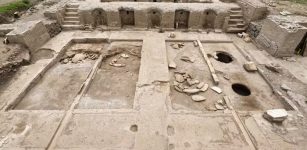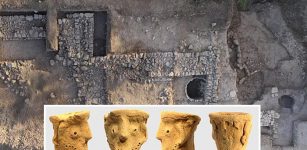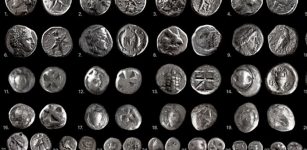The Ruins Of Pennard Castle And The Tale Of Faeries’ Curse
A. Sutherland - AncientPages.com - Very little is known about Pennard Castle, a ruined castle near the village of Pennard in the Gower Peninsula in South Wales.
The ruins we see today are all left from Pennard Castle. Its history records are primarily lost in the mists of time because it was a period of political turmoil and an uneasy rule of Anglo-Norman barons.
Castell Pennard. There was a previous earth and wood ringwork castle here built early C12 which was superseded in late C13/early C14 by this stone castle. It commanded an excellent position on the edge of Pennard Pill and was matched by another on the opposite side of the valley, but the castle was inexpertly constructed for military defence. After only a hundred years or so it surrendered to a natural foe, the encroaching wind-borne sands. Legend tells that this was the result of the castle's Norman baron disrupting the revels of the Telwyth teg (fairy folk) down on the beach below. Image credit: ceridwen - CC BY-SA 2.0
A small settlement grew up near the Castle, complete with a church, but there is no sign of it now. Only part of a single wall of the church remains standing.
Dated to the 12th century, the Castle was a rather primitive construction. It consisted of wooden fortifications with a bank, ditch around it, and a primitive stone hall, probably built by Henry de Beaumont, first earl of Warwick, who was granted the lordship of Gower.
Of this early fortification, only the hall's foundations are still visible. Later, the Castle was rebuilt, and a small settlement grew up around the Castle, complete with a church.
When the Pennard Castle was abandoned is unknown, but by 1400, no one was there. No one else ever moved, probably due to its deteriorating condition.
What happened to the Castle and the village? As far as ancient records say, Pennard was never attacked, so why was it deserted? The only possible answer lies in dunes that enveloped the entire area and destroyed the soft rock walls of the Castle, causing living conditions unacceptable.
Pennard Castle. Image credit: Eiona Roberts - CC BY 2.0
It's unknown exactly when Pennard was abandoned, but the church was out of use in 1532.
Legend has it that the Castle's owner once refused the local fairies the right to dance at his wedding party. The upset little people sent a massive storm, destroying the building.
The owner was a Baron so fierce and ruthless that everyone feared him. His strength and bravery in battle were known throughout Wales. His enemies never dared venture near his Castle. It was here that he passed his time in drunkenness and debauchery.
War was in the land, and fearing defeat, the King of Gwynedd, Lord of Snowdonia, sent a messenger to the Baron asking him for help. Eager for a fight and wise enough to see an opportunity for profit, the Baron returned the messenger to the King, demanding his reward.
The King was desperate; his enemies were collecting a large army in the east, and he knew his throne would soon be lost. The messenger quickly returned to the Baron's Castle.
"Well," bellowed the Baron. "What does your Lord and Master offer that I may take his side in this matter?" "My master commands me to give you this," he replied, handing the Baron a scroll with a royal seal.
Beaumont created a ringwork fort surrounded by a bank and ditch, with a stone hall within the earthworks. Of this early fortification, only the hall's foundations are still visible.
The Baron won this important battle and rode to Caernarfon castle and there were great celebrations. The King was still determined to reward his mighty warrior. The King guaranteed to reward the Baron with anything he desired if they won the battle.
"What prize shall you have? he asked the Baron, ready to empty his treasury. "Name it, and it is yours." "You have a beautiful daughter, Sire. She will be my reward," answered the Baron.
The King was disappointed; this was not the bargain he expected, but he had already given his word. The King's daughter was beautiful but also a bit simple and impressionable.
Some claimed that her friends were fairies and that she spent her days talking to them. The Baron's demand flattered her, and the princess agreed to wed the Baron. With a sad heart, the King bade her farewell. Reaching Pennard Castle, the Baron ordered a great feast. The feasting soon turned to drunkenness with men and women. Drunk and lustful, the Baron grabbed the princess and carried her to his chambers, intent on having her. There was no talk of a wedding ceremony first. Intoxicated and overwhelmed by the Baron's strength, she submitted.
Suddenly, there was a cry from the guards. "An army comes to Pennard." The Baron ran to the battlements and saw a horde of lanterns advancing toward his Castle. He grabbed his sword and ran out to meet the attackers. He cut right and left, slashing and swinging as he ran through the invaders. His sword grew heavy as he fought and his arms burned with pain from the exertion, until he could no longer resist. The lights swarmed around him, and he drove on hacking and chopping.
Finally, he slumped to his knees, exhausted, looking at the blink lights dancing around him and imagining he saw the faint glimmer of gossamer wings.
The same night a mountain of sand blew in from the sea. It was no army but a host of fairies coming to share in the wedding celebrations. As he watched, the wind blew the fairies away, and a violent storm started to batter his Castle. The Castle, the Baron, and the Princess vanished.
Written by – A. Sutherland - AncientPages.com Senior Staff Writer
Updated on October 12, 2023
Copyright © AncientPages.com All rights reserved. This material may not be published, broadcast, rewritten or redistributed in whole or part without the express written permission of AncientPages.com
Expand for referencesMore From Ancient Pages
-
 Hundreds Of Ancient Sealed Wine Jars Found In Mysterious Tomb Of Meret-Neith In Abydos
Archaeology | Oct 2, 2023
Hundreds Of Ancient Sealed Wine Jars Found In Mysterious Tomb Of Meret-Neith In Abydos
Archaeology | Oct 2, 2023 -
 Unique Ancient Roman Winery With Marble Tiling And Fountains Of Grape Juice Unearthed In Rome
Archaeology | Apr 17, 2023
Unique Ancient Roman Winery With Marble Tiling And Fountains Of Grape Juice Unearthed In Rome
Archaeology | Apr 17, 2023 -
 Why Has The Leaning Tower Of Pisa Survived Strong Earthquakes Since The Middle Ages?
Archaeology | May 10, 2018
Why Has The Leaning Tower Of Pisa Survived Strong Earthquakes Since The Middle Ages?
Archaeology | May 10, 2018 -
 On This Day In History: Parachute Jump From 1,000 m Above Paris Is Recorded – On Oct 22, 1797
News | Oct 22, 2016
On This Day In History: Parachute Jump From 1,000 m Above Paris Is Recorded – On Oct 22, 1797
News | Oct 22, 2016 -
 How Common Were Tattoos Among Vikings And Norse People?
Ancient History Facts | May 25, 2024
How Common Were Tattoos Among Vikings And Norse People?
Ancient History Facts | May 25, 2024 -
 Evidence Of A Hybrid Population Of Neanderthals And Modern Humans Discovered At La Cotte De St Brelade
Archaeology | Feb 9, 2021
Evidence Of A Hybrid Population Of Neanderthals And Modern Humans Discovered At La Cotte De St Brelade
Archaeology | Feb 9, 2021 -
 Treasure Trove Of Assyrian Kings Found In Tunnels Excavated And Plundered By Terrorists
Archaeology | Apr 20, 2020
Treasure Trove Of Assyrian Kings Found In Tunnels Excavated And Plundered By Terrorists
Archaeology | Apr 20, 2020 -
 Cosquer Cave And Its Magnificent Underwater Stone Age Paintings Created 27,000 Years Ago
Featured Stories | Apr 20, 2021
Cosquer Cave And Its Magnificent Underwater Stone Age Paintings Created 27,000 Years Ago
Featured Stories | Apr 20, 2021 -
 Mysterious Sanctioned Ancient Temple In Jerusalem Create Some Biblical ‘Problems’
Archaeology | Mar 5, 2020
Mysterious Sanctioned Ancient Temple In Jerusalem Create Some Biblical ‘Problems’
Archaeology | Mar 5, 2020 -
 ‘Impossible’ Ancient Knowledge Of The Gods’ Star – Mysterious Beings – Part 2
Featured Stories | Sep 4, 2021
‘Impossible’ Ancient Knowledge Of The Gods’ Star – Mysterious Beings – Part 2
Featured Stories | Sep 4, 2021 -
 Newspaper Rock Art: Ancient Indian Petroglyphs Tell 2,000-Year-Old Story Of Utah
Civilizations | Nov 28, 2018
Newspaper Rock Art: Ancient Indian Petroglyphs Tell 2,000-Year-Old Story Of Utah
Civilizations | Nov 28, 2018 -
 Incredible Treasure Of Extremely Rare Greek Coins And Aqueduct Found In Ancient Tenea, Greece
Archaeology | Jan 10, 2024
Incredible Treasure Of Extremely Rare Greek Coins And Aqueduct Found In Ancient Tenea, Greece
Archaeology | Jan 10, 2024 -
 Most Important Road In Scottish History Found In The Garden Of The Old Inn Cottage Near Stirling
Archaeology | Nov 16, 2023
Most Important Road In Scottish History Found In The Garden Of The Old Inn Cottage Near Stirling
Archaeology | Nov 16, 2023 -
 Weapons Left By Barbarian Tribes Discovered In Polish Forest
Archaeology | Jan 26, 2024
Weapons Left By Barbarian Tribes Discovered In Polish Forest
Archaeology | Jan 26, 2024 -
 European Neolithic Family Trees Shed Light On Social Organization
Archaeology | Jul 27, 2023
European Neolithic Family Trees Shed Light On Social Organization
Archaeology | Jul 27, 2023 -
 Unexpected Discovery – Medieval Monks Recorded Mysterious Volcanic Eruptions
News | Apr 6, 2023
Unexpected Discovery – Medieval Monks Recorded Mysterious Volcanic Eruptions
News | Apr 6, 2023 -
 Was Biblical Adam A Giant Who Emerged From An Underground World?
Biblical Mysteries | May 24, 2018
Was Biblical Adam A Giant Who Emerged From An Underground World?
Biblical Mysteries | May 24, 2018 -
 Secrets Of The Japanese Shirasaya Sword Mounting
Featured Stories | Sep 11, 2018
Secrets Of The Japanese Shirasaya Sword Mounting
Featured Stories | Sep 11, 2018 -
 On This Day In History: Viking Forces Laid Siege To Paris – On Nov 25, 885
News | Nov 25, 2016
On This Day In History: Viking Forces Laid Siege To Paris – On Nov 25, 885
News | Nov 25, 2016 -
 Significant Mesolithic Site With Unusual Pits Discovered In Bedfordshire
Archaeology | Jul 3, 2023
Significant Mesolithic Site With Unusual Pits Discovered In Bedfordshire
Archaeology | Jul 3, 2023


